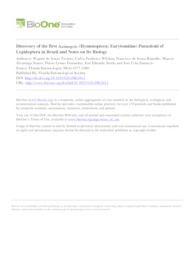Discovery of the first Aximopsis (Hymenoptera: Eurytomidae) parasitoid of pidoptera in Brazil and notes on its biology.
Discovery of the first Aximopsis (Hymenoptera: Eurytomidae) parasitoid of pidoptera in Brazil and notes on its biology.
Author(s): TAVARES, W. DE S.; WILCKEN, C. F.; RAMALHO, F. de S.; SOARES, M. A.; FERNANDES, F. L.; SERRÃO, J. E.; ZANUNCIO, J. C.
Summary: Eucalyptus cloeziana F. Muell. (Myrtales: Myrtaceae) and the tropical almond Terminalia catappa L. (Myrtales: Combretaceae) are widely cultivated in urban and forest areas of many countries where biological control is the most-preferred method to control insects. Aximopsis sp. (Hymenoptera: Eurytomidae) is reported for the first time in Brazil in a new group of lepidopteran hosts. Individuals of this species emerged from the pupae of Thyrinteina arnobia arnobia Stoll (Lepidoptera: Geometridae) and Thagona tibialis Walker (Lepidoptera: Lymantriidae) that developed from larvae defoliating E. cloeziana and T. catappa plants on the campus of the Universidade Federal de Viçosa (UFV) in Viçosa, Minas Gerais, Brazil. Aximopsis sp. was identified by comparing it with species of this group as described for the Neotropical region. Voucher specimens were deposited in the Centre de Coopération Internationale en Recherche Agronomique pour le Développement (CIRAD), France. Twenty new pupae each of Anticarsia gemmatalis Hübner (Lepidoptera: Noctuidae) and Tenebrio molitor L. (Coleoptera: Tenebrionidae) were held individually in test tubes with a drop of honey as food and 3 mated Aximopsis sp. females for 2 d. Aximopsis sp. parasitized 20% of the T. molitor pupae but none of the A. gemmatalis pupae. The duration of the life cycle (egg to adult), parasitism and emergence rates, total individuals emerged from each pupa, sex ratio, length of the body and width of the head capsule, and the longevities of Aximopsis sp. males and females that emerged from parasitized T. molitor pupae were evaluated. The duration of the life cycle of Aximopsis sp. was 14 ± 2 d. An average of 62 ± 5 Aximopsis sp. individuals emerged from each T. molitor pupa, and their sex ratio was 0.96 ± 0.02. The total number of parasitoids that emerged was 248 individuals. Measurements of characters of progeny Aximopsis sp. females (n = 10) and males (n = 5), respectively, were as follows: body length: 3.50 mm (2.40?3.80 mm) and 1.99 mm (1.97?2.02 mm); head capsule width: 0.63 mm (0.58?0.72 mm) and 0.48 mm (0.46?0.51 mm), and longevity: 6 ± 1 d and 4 ± 1 d. These results open prospects for investigations of biological control of pests with this natural enemy.
Publication year: 2015
Types of publication: Journal article
Unit: Embrapa Cotton
Observation
Some of Embrapa's publications are published as ePub files. To read them, use or download one of the following free software options to your computer or mobile device. Android: Google Play Books; IOS: iBooks; Windows and Linux: Calibre.
Access other publications
Access the Agricultural Research Database (BDPA) to consult Embrapa's full library collection and records.
Visit Embrapa Bookstore to purchase books and other publications sold by Embrapa.

